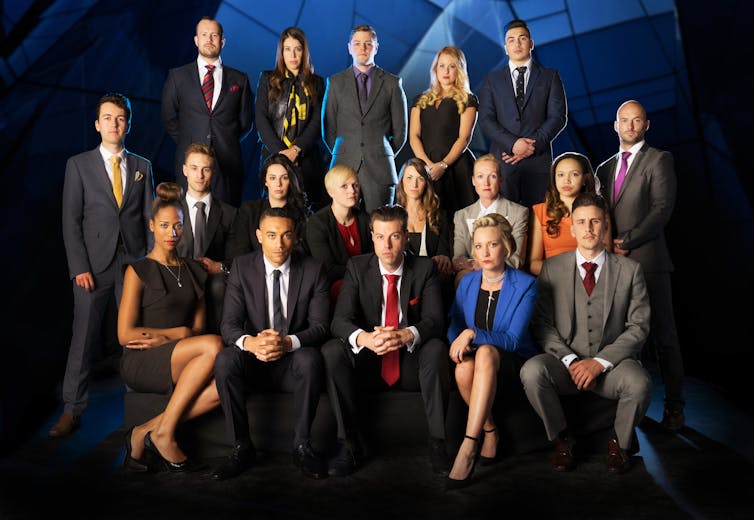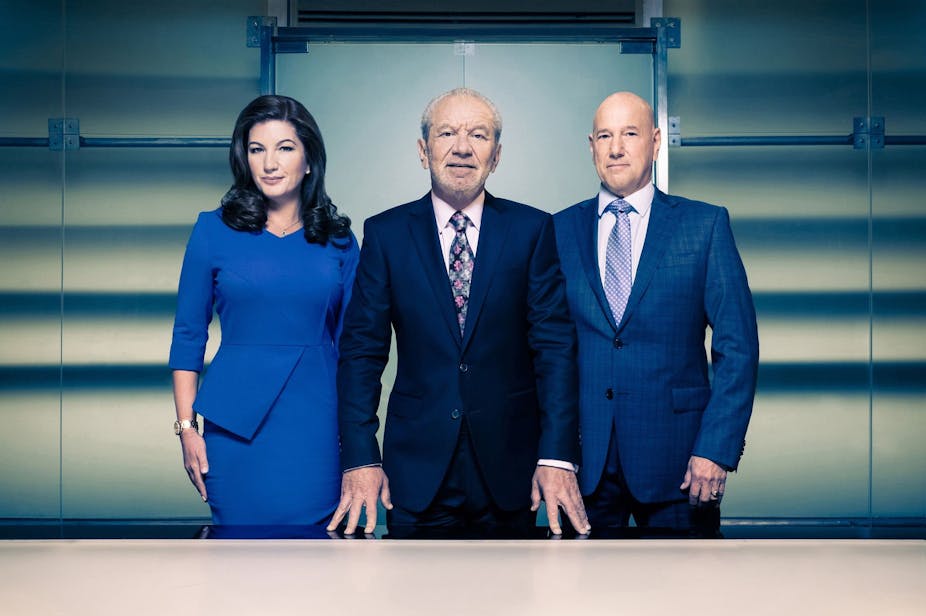Now in its 11th series, The Apprentice is back with its winning “you’ve been fired” format. This season has seen the notable substitution of the oft-puzzled look of Nick Hewer with the stern face of Claude Littner as Lord Sugar’s male confidant. Karen Brady remains as Sugar’s other sidekick.
But just how realistic is this portrayal of the boardroom? Is it as daunting, fearful and terrifying in real life?
Famous for his excoriating one-liners, Sugar could be described as being a little too direct at times. He has berated contestants for going from “anchor to wanker” and said: “I hear your enthusiasm, you know? Great enthusiasm. A fly’s got enthusiasm but it doesn’t stop headbutting the window.”
Is Lord Sugar right: is it better to be feared than loved as a boss?
Lord Sugar – at least on screen – displays some autocratic tendencies, suggesting that he subscribes to the traditional management approach which says leaders must be tough, manipulative, dictatorial and maybe even authoritarian to meet objectives. But a significant amount of research into management best practice opens this traditional approach up to interrogation.
Fear vs love
Behavioural scientists Cuddy, Glick and Beninger argue that only two traits govern how people judge individuals and leaders: warmth and competence. First, how loveable are they? Are they approachable? And second, are they strong, trustworthy and good at what they do?
Typically, leaders tend to focus on demonstrating their strength, which according to Cuddy, Glick and Beninger’s research, creates the wrong perception as it often evokes a sense of fear in people. Fear is a much used management tool but has the capacity to undermine people’s confidence. It can stifle their potential creativity, problem-solving skills and desire to take healthy risks.
Not that everyone agrees entirely. Professor of human resources management, Kets de Vries, argues that fear does work as a management technique – albeit only for a short period of time and within limits. You have to respect people because if you go on inducing fear, day after day, it ultimately will incapacitate them.
Lord Sugar’s fearsome television approach may be fine for a short time, then, but will likely stifle his candidates’ creativity and performance in the long run.
Rule of one, or many?
Some also may point out that The Apprentice differs from the real-life boardroom because Lord Sugar calls all the shots. Companies tend to have a board of directors with different responsibilities, the idea being that the board has representatives from different areas of the business who are knowledgeable and responsible for specific performance within their areas.
In practice, however, this does not necessarily mean that boards are not dominated by certain members. Some research shows how a board’s structure is not able to counter the biases which can arise in its members. Judgement may be distorted by “conflicts of interest, deference to authority, peer pressure, emotional attachments, and inappropriate reliance on previous experience and previous decisions”. One study by Warwick Business School professor, Nick Chater, shows how boards demonstrate “groupthink”, where they reach consensus decisions even where few or no group members would choose that option.
This is supported by previous research, which highlights the negative potential outcomes for individuals and organisations which can arise from a toxic triangle of destructive leaders, susceptible followers and environments that support this. It seems that attempts at corporate governance may be negated by biases and groupthink in the board, especially where there is an autocratic leader. Thus, it seems that even if Lord Sugar’s television persona were to aim for a consensus there is no certainty that the remainder of the board would exercise independent judgement. They may just be ineffectual “yes men”.
Diversity in the boardroom
As far as gender and race diversity among the candidates is concerned, The Apprentice 2015 seems to have done reasonably well – it’s a 50/50 split between men and women from what seems to be a diverse range of ethnic backgrounds, reflective of wider British society. This is in keeping with practice in previous years.

Lord Sugar’s boardroom does not, however, include any visibly disabled candidates for the 11th year running. As Toby Mildon, Diversity Project Manager for BBC Future Media said of last year’s line up: “I am disappointed that yet again there’s no visibly disabled candidate on the show … By not featuring disabled candidates, we’re sending out a message that a boardroom is not inclusive or open for business to disabled people.”
Furthermore, as Ruth Cooper-Dickson of diversity consultancy Equal Approach has pointed out: “The average age of candidates has trended downward since the show began: in series one, it was 31, and … in series ten it’s 28, and the winners are often even younger, with the average age of an Apprentice winner being 27.”
But in Lord Sugar’s favour, his boardroom is probably more diverse than a typical FTSE or Fortune 500 one, which is more likely to be male and white. The number of women on FTSE 100 boards has only recently topped 25% for the first time. Meanwhile, 62% have all-white boards.
So, overall, for better and for worse, The Apprentice boardroom fails to match up to the real-life boardroom. And while he undoubtedly instils fear in the contestants who enter it each week, even the plain-speaking Lord Sugar can be said to be tame in comparison to Fred Goodwin, whose boardroom RBS managers referred to as the “torture chamber”.

